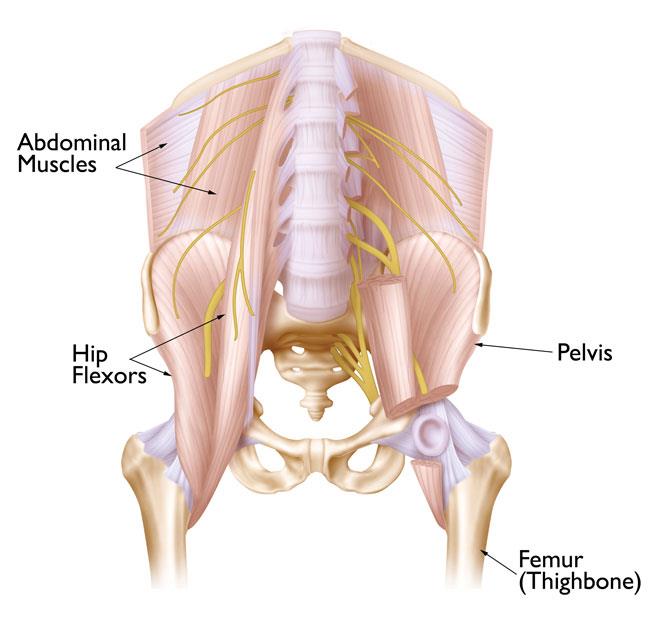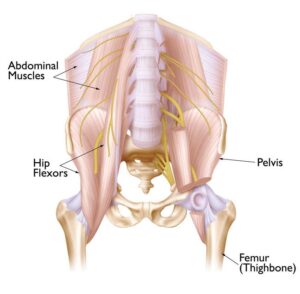Hip strains can range in severity, with more serious injuries significantly restricting hip mobility. While these strains can occur during routine daily activities, they are most commonly associated with sports and physical exertion. Mild hip strains often respond well to basic home care, but more severe cases may necessitate physical therapy or other professional medical interventions to restore function and alleviate pain.
Cause
Hip strains can occur suddenly as a result of acute injuries, such as a fall, a stretch injury, or a direct impact during contact sports. They can also develop gradually due to overuse, where repetitive movements weaken the muscles or tendons over time.
Certain factors can increase the risk of experiencing a hip strain, including:
- A previous injury in the same area
- Tight muscles
- Inadequate warm-up before physical activity
- Overexertion or attempting to progress too quickly during exercise
- Fatigue or lack of proper conditioning
Understanding these causes and risk factors is key to preventing hip strains and maintaining hip joint health.
Symptoms
Muscle strains in the hip typically cause localized pain and tenderness in the affected area. Other common symptoms include:
- Increased pain during movement or when using the injured muscle
- Swelling around the site of the strain
- Reduced range of motion in the hip joint
- Muscle weakness, which can affect mobility
Recognizing these symptoms early can help prevent the condition from worsening and guide appropriate treatment.
Home Remedies for Hip Strains
Most mild hip strains respond well to at-home treatments. One of the most effective approaches is the RICE protocol, which stands for Rest, Ice, Compression, and Elevation:
- Rest: Refrain from activities that put strain on the injured hip for the first few days. Allow the area time to heal.
- Ice: Apply a cold pack to the injured area immediately after the injury to minimize swelling. Use ice packs for 20-minute sessions multiple times a day, ensuring the ice does not directly contact your skin to prevent frostbite.
- Compression: Gently wrap the affected area with a soft bandage or use compression shorts to limit swelling and provide support.
- Elevation: Whenever possible, elevate the leg so it rests above heart level. This helps reduce swelling and encourages healing.
Additionally, over-the-counter nonsteroidal anti-inflammatory drugs (NSAIDs), such as ibuprofen or naproxen, can help alleviate pain and reduce inflammation.
If the pain persists, swelling worsens, or it becomes increasingly difficult to move your hip or leg, consult a healthcare professional for further evaluation and treatment.
By following these steps, most hip strains can be managed effectively at home, promoting quicker recovery and a return to normal activities.
Doctor Examination
Physical Examination
During your visit, the doctor will assess your overall health and ask about the circumstances surrounding your injury. A physical examination will involve checking the hip and leg for signs of tenderness, swelling, or reduced mobility. The doctor will apply pressure to specific muscles and move your hip and leg in different directions to evaluate your range of motion and pinpoint the affected area.
You may also be asked to perform various stretches and movements, helping the doctor identify which specific muscle or tendon is injured.
X-Rays
X-rays are commonly used to create images of dense structures like bones. To rule out conditions such as a hip stress fracture—which shares similar symptoms with muscle strains—your doctor may request an X-ray. However, in most cases, no additional imaging tests are required to confirm a hip strain diagnosis.
Treatment Options
Nonsurgical Treatment
Most hip strains can be managed without surgery. Treatment focuses on relieving pain, restoring strength, and improving mobility. Along with the RICE protocol and anti-inflammatory medications, the doctor may suggest:
- Crutches: To limit weight-bearing on the affected hip, crutches might be recommended for a short period.
- Heat Therapy: While ice is ideal for reducing swelling during the first 72 hours after the injury, heat therapy—such as hot baths, heat lamps, or heating pads—can later be alternated with ice to relieve pain and improve flexibility.
- Home Exercise Program: Specific exercises designed to strengthen the hip muscles, enhance flexibility, and improve endurance may be prescribed.
- Physical Therapy: If pain continues after several weeks of home care, formal physical therapy may be recommended. A physical therapist can create a personalized exercise program to support your recovery.
Surgical Treatment
Surgery is rare and typically reserved for severe injuries where tendons are completely detached from the bone. This procedure involves reattaching the torn tendon to restore full functionality and mobility. Many severe strains, however, are successfully treated with nonsurgical methods. Your doctor will discuss the best treatment plan tailored to your needs.
Recovery and Prevention
Recovery Timeline
Most mild to moderate strains require a rest period of 10 to 14 days. Severe strains may take longer to heal, and you should avoid any strenuous activities during recovery. If pain resurfaces after resuming physical activity, reduce the intensity and return to lower-impact exercises until the injury has fully healed.
Prevention Tips
To prevent future hip strains:
- Exercise Regularly: Strengthen muscles with a consistent exercise routine suited to your age and activity level. Consult your doctor for recommendations.
- Warm Up Properly: Begin workouts or sports with a thorough warm-up to increase blood flow, raise muscle temperature, and improve flexibility.
- Use Protective Gear: Wear the appropriate equipment for your chosen sport to minimize injury risks.
- Cool Down Gradually: After exercising, stretch slowly and hold each position to enhance muscle recovery and flexibility.
- Allow Adequate Healing: Avoid returning to intense activities until your muscles regain their full strength and flexibility.
By following these steps, you can reduce the risk of future injuries and maintain optimal hip health.







